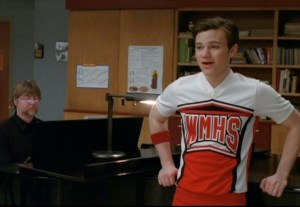
FOX
After last week’s Madonna-opera, last night’s Glee, “Home,” was a welcome return to the show’s roots—insofar as any show that’s been on the air for less than a season can be said to have roots. It wasn’t an episode on par with the series’ best, like “Preggers” and “Wheels” from Glee’s fall run, but it reined in the show’s recent determination to cram in as many soundtrack songs as possible, reminding us that what makes Glee worth following is not just the music, but the stories that the music serves (rather than vice versa).
By far the strongest plotline was the potential Brady-Bunch-ification of the Finn and Kurt households. Glee has sometimes had a hard time giving its adult characters as much depth and plausibility as the kids (see not just the fake pregnancy but also “Acafellas”), but Kurt’s dad and Finn’s mom have always been exceptions. As opposed to some of the sharply drawn satirical characters on the show, they come across as actual parents you might expect to meet in Lima, Ohio, and their plight is one that echoes many of Glee’s high school storylines: loneliness and the need to connect.
The way Kurt brings them together and then tries to keep them apart both drew on what we already knew about the show and managed to surprise. It began by returning to Kurt’s established crush on Finn (which, to the show’s credit, the straight Finn has always reacted to neither with grossed-out shock or patronization, but the kind of polite wariness that makes his character so adorable). But it ended up being about Kurt and Finn’s own relationship with their parents: Kurt’s continued insecurity about how well his dad really accepts him, and Finn’s insistence on clinging to the memory of his late dad. What really elevated the plot, though, was that even as it focused on the two Glee-club characters that we’re closest to, it also emphasized that their parents are three-dimensional people with their own needs, who don’t just exist to serve the kids—or us, the viewers.
Mercedes’ body-image storyline, on the other hand, was an example of one of Glee’s most frustrating habits: giving characters abrupt personality shifts and crises, then re-reversing them within the space of an hour. (See Rachel’s sudden crush on Will, which barely lasted a few commercial breaks.)
On paper, the story worked: Mercedes joins Cheerios, badly wants to be popular, and subordinates herself, and her self-esteem to the group’s demands. But there’s a difference between telling us that a character has deeply changed and showing it through plausible evolution, and Glee often lacks the patience for the latter. One problem was the point Quinn made during her brief appearance: Mercedes has always had tremendous confidence and a positive body image. Could a teenage girl lose that? Of course! But not in the space of a couple conversations, just in time to have a sudden health crisis, then regain her confidence in time to sing Xtina’s “Beautiful.” Given the chance to play out as a subplot developed over a few episodes, it could have been powerful, and the climactic pep-rally number would have seemed earned. (It also would have been a better, less glib, way to deal with the serious issue of eating disorders.) But Glee is too often in a hurry to move on to the next thing.
As for the return of April, it was neither especially good nor especially bad: it gave the show the chance to utilize Kristin Chenowith again—and it showered her with a couple extra-long musical numbers—but the story itself wasn’t especially absorbing. Still, overall “Home” at least left me optimistic that Glee is not entirely becoming a jukebox designed to move product on iTunes.
The thing about Glee is that its audience is a confederation of people who like the show for sometimes entirely different reasons: for the songs, for the darker small-town stories, for Sue Sylvester’s zingers, for the don’t-stop-believin’ uplift, for the realistic drama, for the heightened melodrama. And, of course, there are people who like all of the above. Often, Glee zigs back and forth among these constituencies: a light episode here, a dramatic episode here, a music-heavy episode there. My ideal Glee would integrate those aspects into each episode under one big roof.
Now a small hail of bullets:
* It was good to see Dianna Agron get some work in her sit-down with Mercedes, as Quinn’s been rather invisible lately. But as a reader on Twitter pointed out to me—you’d think an episode called “Home” might have spent a little more time with a character who was kicked out of hers. That did still happen, right?
* As much as I might criticize the Mercedes subplot, the low-tech food costumes were hilarious.
* Brittany-ism of the week: “Sometimes I add a teaspoon of sand.”
* I’d been worried that Sue could become one of those breakout characters who takes over a show and wears out her welcome. “Home,” I thought, kept her better in balance with the weight-loss story–“One time when I needed to make weight for a cheer competition, I had an elective hysterectomy”–and the magazine-profile subplot.
* Speaking of which, I have to join every Glee-watching journalist in the world in noting that the reporter could not have been nominated for a Pulitzer with Newsweek, because Pulitzers are not awarded to magazines. (Which I’d think Ryan Murphy, a former Miami Herald reporter, would know.)
* Though I’ve criticized Glee for drawing from the American Idol well for song choices, I had to love Chris Colfer’s read of “A House Is Not a Home” (see Tamyra Gray, season one); Glee can do a Bacharach/David night any time it wants. Also: “Toile? I always pegged you as a chinoiserie type.” Me too!


